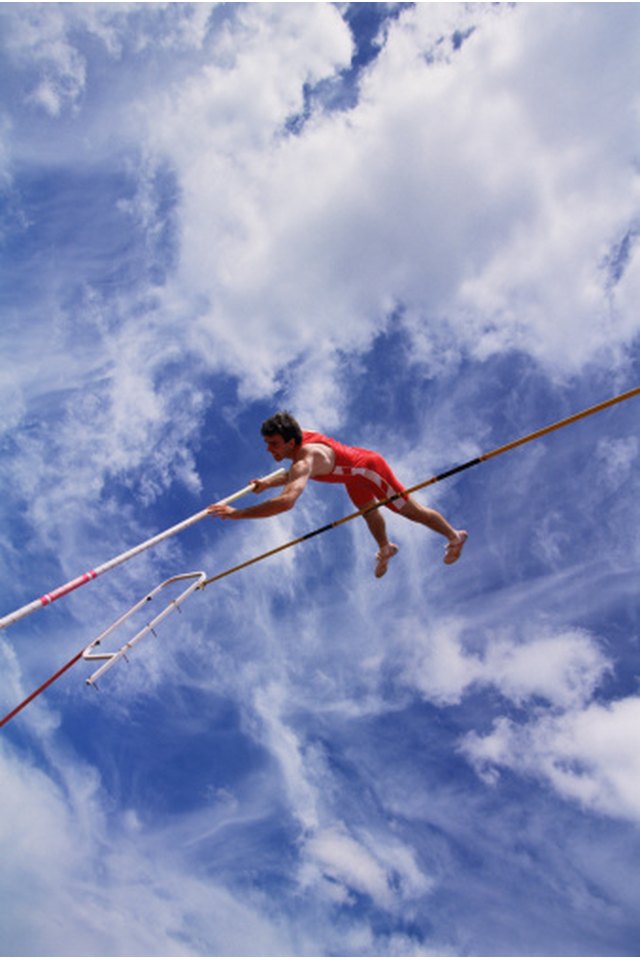Types of Throwing & Jumping Events

The sport of track and field consists of running, jumping and throwing events, several of which trace their origins as far back as the ancient Greek Olympics, including the discus and javelin. In modern competition, track and field contains four throwing and four jumping events, with a division for men and women in each event.
Long Jump
The long jump requires jumpers to catapult forward as far as possible into a sand pit. Jumpers take a running start toward a takeoff board and when they reach the board they must jump forward. If a jumper's foot crosses the end of the takeoff board, the jump does not count. Each jumper gets three attempts and the farthest distance is the jumper's official score.
High Jump
High jumpers must clear a crossbar that is approximately 13 feet long. The jumper runs towards the crossbar, then leaps upwards over the bar, either face down or face up. Each jumper may attempt a height three times. After the jumper clears the height, officials raise the crossbar. If a jumper hits the crossbar or knocks it down, the jump does not count.
Triple Jump
Triple jumpers run down a short pathway, then launch off a takeoff board and proceed to use three long leaps to jump as far as possible. Jumpers alternate feet for each leap and they may not cross the end of the takeoff board before jumping. Each jumper gets three jumps and the farthest distance is the jumper's score.
Pole Vault
Athletes in pole vault competition attempt to clear a crossbar by propelling themselves up and over the bar using a long, flexible pole, measuring 13 to 16 feet for leverage. The athlete runs down a short track and plants the pole into a box on the ground, then bends the pole and swings her body up over the crossbar in a position that resembles a handstand. The athlete gets three attempts to clear each height, and officials raise the bar after a successful vault.
Javelin
The javelin event uses a long, thin spear that has a minimum length of 7 feet 2 ½ inches for female throwers and 8 feet 6 ¼ inches for male throwers. The women's javelin weighs a minimum of 1½ lbs. and the men's javelin weighs a minimum of 1 ¾ lbs. The thrower takes a running start toward a check line, leaning back with the javelin behind them. At the check line, the thrower quickly propels the javelin forward as far as possible. The athlete's foot may not cross the check line, and the javelin must land within the established boundaries of the throwing field.
Discus
The discus is a round object made of wood or metal that weighs 2 lbs. 3 ozs. for female athletes and 4 lbs. 6 ozs. for male athletes. The thrower grips the discus in the palm of his hand and stands in a throwing circle. The athlete holds the discus with is palm facing downwards and spins in the circle to build momentum, then releases the discus forward onto the throwing field. Athletes may not place a foot outside the throwing circle and all throws must land with in the boundary lines drawn on the field.
Shot Put
The shot put event requires the athlete to throw a metal ball as far as possible. Male athletes throw a shot that weights 16 lbs., and female athletes throw a shot that weighs 8 lbs. 13 ozs. The athlete places the shot against her neck and turns facing away from the field, then slides backwards towards the footboard and turns and pushes the shot forward. Shot putters get three attempts to throw, with the farthest throw counting as the official score. Athletes who touch the top of the footboard or step over it lose the score for that throw.
Hammer Throw
The hammer throw requires athletes to throw a ball attached to a wire and handle as far as they can. The ball weighs 8 lbs. 13 ozs. for women and 16 lbs. for men. The athlete stands still and rotates the ball behind their body to build momentum, then releases it in an upward arc. Each athlete has three attempts to throw the hammer and the farthest distance is the official score.
References
Writer Bio
Heather Potter has more than 10 years experience as a writer. She specializes in travel writing, and her writing has appeared on national websites, including USA Today. She attended Boston University.
